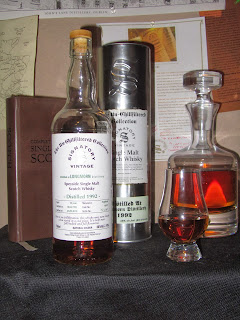Review 186
11/23/13
Aberlour
16 Year: 43% abv
Background: Back in
Review 126, we reviewed Aberlour 12 Year. Both Aberlour 12 Year and Aberlour 16
Year are “double casked”, which means they are aged in two separate barrels.
They’re both bottled at 43%, they both move from a bourbon to a sherry cask, so
this is a pretty good comparison of what 4 extra years of maturation will add
to a whisky. Two batches were separately aged in sherry and bourbon casks for
16 years each, and then blended appropriately to get the right flavor. When we
reviewed the 12 Year, we said it lacked the complexity to compete with some of
the other Scotches we’ve tried. The big question now is, did the extra time
help to add to the complexity of this big branded Scotch.
Straight
Nose: The
nose starts off with rich notes of chocolate and caramel. There is a definite
presence of raison sherry and rich fruits. The fruit flavors include
strawberries, raspberries, and cranberry. There is an odd hint of banana
present as well. All of these fruit flavors mix well with an aroma of yogurt.
There is a suggestion of Murphy’s Oil that hides in the back of the nose, but
does not dominate. There is a little bit of malt grain flavor, but being a malt
addict, there could be much more. There is a miniscule herbal note of parsley.
Arrival: There is a nice creamy, malt flavor that comes
through in the arrival, which is nice and refreshing. There is a bit of caramel
syrup flavor that compliments the malt flavor. The arrival is pretty woody,
with a bit of oak and interestingly maple as well. There are some fruit notes,
with some berries and apples at the forefront. From the arrival into the body,
there is a strawberry jam flavor.
Body: There
is a definitive woodiness that starts to build up in the body. This should be
expected from the 16 Year old. A pleasant orange peel is also present in the
body. Again, apple is present here. The sherry comes through here with a creamy
yogurt covered raison flavor. A noticeable amount molasses and agave are
present in the body as well. The body also takes on a confectionary sweetness.
Finish: The
finish has a variety of complex flavors, including banana, salted caramels, and
malt. There is a lot of malt flavor in the finish. There is a good amount of
candy strawberry flavor in the finish, with some marmalade as well. The fruity
flavors are still lasting through the finish. There are also some sweet
cinnamon and pepper notes that sit in the background as well. The confectionary
notes in the body carry through to the finish, and a sweet cookie-like flavor.
With Water
Nose: The
nose has more hints of maple and fall spices. There is definitely more cinnamon
and nutmeg after water is added. The nose is a little more dry and astringent,
with some lemon zest in the nose. The orange peel is dominant as well. The
maltiness is a little more noticeable as well. There is also some vanilla on
there as well.
Arrival: The
malt is more dominant now than before, with prominent citrus notes. There is a
black cherry tartness, coupled with some vanilla.
Body: The
fruitiness is a little bit less dominant in the body now. The orange peel as
now become more akin to an orange juice flavor, and the overall experience is
more creamy than before. There is now actually a big almond flavor that wasn’t
present without water. There is a little bit more saltiness in the body now as
well.
Finish: There
is more cherry in the finish now, adding to the tartness. There is still thick,
confectionary sweetness. The finish is now slightly grassy, and somewhat
medicinal as well.
Final Comments: This is a major step up in quality and
complexity from the 12 Year, as we see it. The difference between the two is
substantial. The question should then arise to the astute reader as to whether
or not the price difference in these similarly styled whiskies is worth the
upgrade. In our minds, it seems like the difference is noticeable, but for the
novice drinker, it might not be worth the price jump. In either case, this is a
very solid whisky for a casual, sweeter sipper. And while Balvenie
differentiates their range with different casks and styles, Aberlour keeps the
sherry/bourbon theme throughout their brand. This makes Aberlour a great source
for consistent sherry-style Scotch in different age groups.
Why you’d buy it: A great
sherry-style Scotch at a reasonable price
Why you wouldn’t: Glendronach
is starting to expand its presence in the US.
Score: 9.0/10





